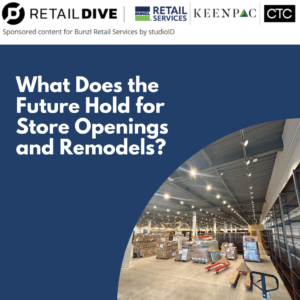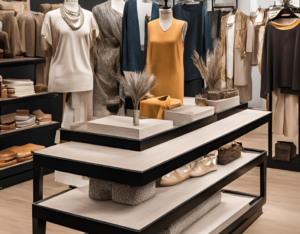
Why is a Cohesive Multichannel Shopping Experience Important?
How retailers can create a seamless brand experience in-store and online
We recently mentioned in our blog on the Post-Pandemic Supply Chain that it’s extremely important for retailers to offer a consistent multichannel experience. Shopping has always been a multi-faceted journey, but with the digital advancements of the last two decades, it has become more complex than ever.
Why do retailers need to provide a cohesive shopping experience?
A unified retail experience across channels is key to building brand loyalty and sales.
As retailers know, the shopper experience doesn’t end when they walk out of a store. It’s a complex journey with touchpoints along the way, from social ads to browsing websites and third-party marketplaces, and one that hopefully ends with a purchase.
Shopify shares that customers who have positive experiences with your brand are three times more likely to recommend you to their networks. These trusted personal recommendations are a strong way to influence future purchases and gain new customers.
Offering an enjoyable customer experience that keeps shoppers coming back is paramount for success, with up to 86% of customers willing to pay more for a better customer experience according to a Walker study.
Six Ways Retailers Can Create a Consistent Omnichannel Shopping Experience:
1. Consistent and Recognizable Branding
Your store atmosphere and décor are the prominent ways to express your brand personality. Creating custom signage and standout displays also showcase your brand in a visible way in-store. But how does that brand translate to other channels?
Even if your retail brand doesn’t have an eCommerce offering or online sales, customers are still interacting with your brand digitally. Whether it’s through social media pages or a website, visitors to your online address should feel the same as walking into your store.
Conduct an audit of your website. Does its imagery, messaging and overall aesthetic match the brand and in-store customer experience?
2. Personalized Customer Service
How does your online customer service compare to the in-store experience? Do your shoppers face delays or have trouble contacting an associate—whether in aisle or browsing online?
Customer service from team members who truly know the brand and its products inside and out offers the most value for a retailer.
When it comes to online, the expectation is that shoppers can submit a specific question on a product and have it answered by a real person within minutes.
Respecting a customer’s time online is one of the most common complaints. 53% of shoppers even say they will abandon an online purchase because of a slow customer service response.
For luxury brands, an online shopping experience that’s a cut above average is expected. For example, Nordstrom includes many informational product videos with knowledgeable associates showcasing its features and providing a better look, while customer service teams stand by to answer questions in more detail.
3. Connected Data
Advanced Analytics and integrated data can better predict and manage inventory to avoid delays and out-of-stock situations. Especially with third-party marketplaces, retail brands want to ensure they are tightly synced and reflect accurate information so they don’t have to cancel orders unexpectedly.
Closely tracking shipping to keep customers apprised of progress and the ability to communicate any delays is another important aspect of the shopper
Precise inventory insights also help bridge the gap and drive customers in-store as checking in-store availability online before a trip is becoming part of the shopping process. A website that reflects real-time inventory data helps shoppers feel confident that they can easily find what they are looking for on a visit to your brick-and-mortar retail store.
Buy Online Pickup In Store (BOPIS) is an important element of connected data and shopper experience for retailers. This omnichannel shopping method is becoming more popular every day, with 59% of consumers reporting that they are interested in BOPIS-type shopping options, according to Shopify.
4. Packaging That Acts as an Extension of Your Brand
Packaging Style
How does your in-store purchase experience compare to online? If your retail stores hand over purchases that are delicately wrapped in tissue paper and placed in a beautifully designed bag, is this same plush experience felt through an online sale?
Creating recognizable packaging is another great way to extend your multichannel retail brand. A green brand may carry its style over to the eCommerce environment with sustainable, Earthy shippers while a tech-focused company may utilize something more intricate and chic. Consider including your brand colors or shapes in retail packaging to further extend your branding outside of the store.
The style of your retail packaging is extremely important and lots of care and planning likely went into its selection in-store. But do your online sales reflect the same look? If not, get in touch with a packaging and design expert who can make recommendations to fit your brand and needs.
Packaging Quality
All boxes are not created equal. In fact, we shared a recent blog on four of the most common packaging mistakes we see retailers make that has some great tips on what to avoid.
With costs always a focus, packaging quality can often be overlooked or undervalued. But poor packaging quality can give a very negative impression of your brand and end up costing more in damages, returns, and lost business in the long run.
Retailers should examine the sort of quality felt through their retail packaging and weigh if it is up to their brand standards. Consider the texture and weight of the package as well as the durability and what it looks like when it finally lands on your customer’s doorstep.
5. Showcase Your Values
Examine how your brand values are portrayed across digital channels and in-store. How are they experienced through the shopper’s journey? Ideally, brand values should be apparent and aligned at every step of the way.
For example, if part of your brand ethos is an emphasis on caring for the environment, but you ship a cell phone case-sized item in a huge, oversized box, it may not be consistently portraying that.
6. Find the Right Partner
The right retail operations partner can make many of these elements simpler and help shoulder the burden of creating a cohesive multichannel experience. Utilize a vendor who can provide detailed insights, demand planning and connected data better predict inventory and track shipments.
Creating custom shopper bags and shippers that look and feel like a handheld representation of your brand can also help bring the in-store experience in home.
***
What are some of your biggest struggles with creating a cohesive omnichannel retail shopping experience? Tag us on LinkedIn @BunzlRetailServices and share your thoughts.
Written July 13, 2022 by Bunzl Retail Services staff writers.





